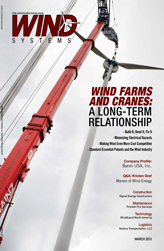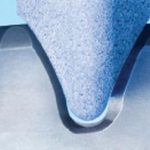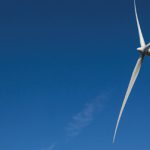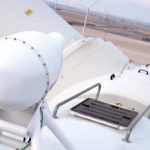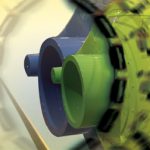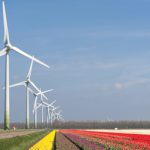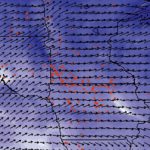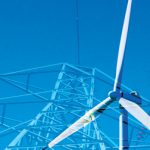We are all familiar with the important role that heavy haul transport and large cranes have in the erection of turbines. But after all the excitement during construction is over and commissioning is complete, you may not know the extent of their involvement throughout the life of the wind farm including maintenance and end-of-life.
At the beginning of a wind farm project, companies such as NCSG Crane & Heavy Haul Services, one of the largest owners and operators of heavy haul transport and crane equipment, are contracted to transport the turbine components from the port or rail head to the wind farm site and then to the crane pads. For optimal results, it is important that the crane owner/operator’s engineers be part of the pre-construction design team, and, well before the crane pads are constructed, to ensure that the specifications for the crane pads are consistent with the turbine type and weight that will be erected. This is especially important when turbine erection is not the responsibility of the EPC Contractor who is responsible for the pads.
Prior to transporting the turbine components, our engineers work closely with civil engineers to help design the site routes to ensure that the large transport equipment can safely negotiate the hills, corners, and curves as well as the site entrances and exits to least impact the flow of local traffic. Transport problems encountered such as state and local permitting issues that can include: (1) different allowable weights and dimensions for each state; (2) time of travel restrictions; (3) curfews; (4) weather; (5) road conditions; and (6) the problems of managing pilot/escort vehicles. On reclaimed sites, the issue of site access is a constant problem.
During planning stages of the transport of a wind project, experienced heavy haul personnel must survey routes to insure the safe and legal transport of the components.
Many hours of pre-job planning go into designing an erection schedule to meet transport and site deadlines. The components must be strategically off-loaded and placed in strategic positions around the crane pad to ensure that the erection cranes can lift each component while maintaining a safe working load on the crane.
We start with a site evaluation to create the lift plan ensuring proper area for movement and sufficient compaction of soil to ensure a stable hoisting base. Every pick is preceded by a pre-lift meeting. All parties involved assemble to discuss the task, plan and concerns. Signatures are required to be documented for every person attending a pre-lift meeting. NCSG is presently arranging for two Health, Safety, and Environment employees to become Certified Trainers in High Angle Rescue. This provides us with the unique ability to train our own employees the specifics to the tower brand and client configurations. This will provide NCSG, tower authorized employees a professional level of training, expertise and qualifications that few other crane companies are able to provide. By spring 2013 all NCSG tower authorized employees will be competent or authorized to go up any tower with any client, only having to receive site specific training. The training provided includes fall protection, first aid and rescue skills. Our employees will be capable of assisting a client or other contractor in rappelling to the ground in rescue or self-rescue mode. Figure 1
NCSG preceded federal requirements for crane operators and riggers. We require ALL operators and riggers to be NCCCO qualified. In addition to certifications we provide operator and rigger competency evaluations. All field personnel are visually verified as being competent or qualified prior to be dispatched to a project. Junior level or new hire operators will operate under the guidance of one of our senior “expert” operators prior to being allowed to take control of a lift. Ground crews typically include an A&D Director. This individual is someone who through work experience, education and qualifications has mastered the skills required to assemble and disassemble a crane. Each employee has a specific task and contributes their specific skills to reduce the likelihood of an incident or accident. Every task we face is preceded with safety in mind. Electrocutions are the number one cause of death within the crane industry.
The second leading cause of death is assembly and disassembly of cranes. By understanding this challenge we confront the hazards with education, training and execution of expertise. We have an EMR (Experience Modification Rate) which consistently ranks NCSG as having approximately one-half the industry average of incidents and accidents. This is not an achievement of any one person or department but relies solely on the employees as a whole. Each and every person contributes greatly to the success of our program. From new hire evaluations to computer based and hands on training to mentoring, each step we take is planned and monitored to ensure success. Employees are encouraged and often times rewarded for refusing to perform a task which they believe may be unsafe. It takes all eyes of every person onsite to achieve and maintain progress in our journey to zero incidents/accidents. The job is never done working towards safety, we just elevate our place on the stairs of life working to be the safest company our employees and clients will ever hope to work with. Figure 2
All employees are tasked with continuing professional development. Within the HSE department, education and networking are invaluable tools. During the AWEA workshop held in San Diego this past January, NCSG was accepted as a member of the AWEA / OSHA Safety Committee. NCSG will be representing the crane industry within the association. Additional responsibilities will fall within the construction of wind towers and their specific committees. Meetings and calls are held each month to discuss an agenda and to work on solutions to problems. This allows for laws to be written to best protect employees working within the industry and to reduce exposure to clients in the building of the towers. This membership will allow NCSG / Mullen to represent what we see as “best practice” within the industry and will keep us at the forefront of compliance. Following the AWEA workshop, we were asked to nominate a board member for the Montana Safety Council.
At the wind site, the cranes are brought in by multiple types of trailers and are met onsite by the erection crew and site supervisor. Upon arrival of equipment, the crew, under direction of the supervisor, starts the assembly of the large primary lift crane. During erection and assembly a checklist is used to ensure that all components are assembled and secured prior to lift of personnel or equipment. Only after completion of the checklist and authorization of the site supervisor is the assembly task completed. Each lift is specific to the task required by the client. Some or all of the work may be performed by use of a manbasket suspended from the crane. Prior to any lift of personnel, a trial pick is made with the supplied test weights and suspended for a pre-determined amount of time. The basket is then lifted into the same position required for the workers and brought back to the ground. This provides a proven “practice run” for the basket and the crane. Any difficulties which may have provided an obstacle to the actual work is remediated prior to personnel leaving the ground. Figure 3
All wind sites are different and therefore a different set of risks and challenges need to be considered in the erection and maintenance plans. It takes a multitude of cranes to efficiently erect a wind project as well as an experienced management team to maintain the site schedule. During crane erection, a primary lift crane such as a Manitowoc 16000, 440-ton capacity conventional crawler and an assist crane such as a Grove RT890E, 90-ton capacity rough terrain crane will perform the lifting work for each turbine component. This process can take several days, depending upon environmental conditions such as wind speeds that exceed the level to perform the work in safe conditions.
Proper maintenance of each crane and heavy haul transport equipment is paramount to ensure adherence to the project schedule, project budget and safety of the operators and other personnel. Training of the operators and support personnel on correct use of the equipment and of the task at hand including familiarity with the turbine type all contributes to a successful outcome and removes risk associated with this type of work.
During the 20- to 25-year operational life of the wind farm, certain activities such as gearbox, generator and main shaft components, and blades require removal and replacement. Heavy haul transport companies are responsible for moving the replacement component to the site and returning the component to a repair facility. Depending on the turbine type and availability of tools, the rotor may need to be dropped in order to remove the gearbox and generator. If a rotor must be dropped, a large main crane and a smaller assist crane will be required to be on site. This process generally takes one working week. If a rotor is not required to be dropped, the work can be performed with a less expensive crane, for example a large hydraulic truck crane and the process can be completed in fewer days.
Many wind farm owners remove the crane pads after turbine erection is complete and restore the roads to their original state. However, these actions present a challenge for the transport and cranes to be able to safely access the site and complete the required actions. If permissible, it would be advantageous if the crane pads remained in place and the roads maintained. These would lead to cost reductions due to less time to transport the equipment from the main roads to the turbines and the cost to bring crane pads to the site.
Due to the remote locations of many wind farms and the expense of the crane mobilization and demobilization, it is optimal if the crane equipment can service more than one turbine during its visit to the wind farm. This is often not feasible but with advancements in predictive analysis from SCADA data, it is anticipated that more opportunities to achieve these economies will be realized.
Wind farms that were installed over 20-30 years ago are now starting to experience end-of-life and repurposing efforts. In some cases, the older turbines are removed and the land is restored to its original state. In other cases, the old turbines are removed and new turbines are erected as recently started to occur at the Altamont Pass wind farm in California. Cranes are an integral part of these processes and heavy haul transport is responsible for moving the retired components to the designated location for disposal and recycling.



















